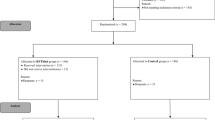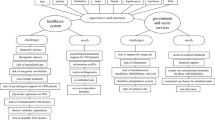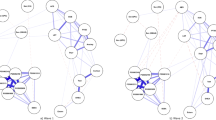Abstract
Developmental and experiential heterogeneity associated with caregiving-related early adversities (crEAs) poses a major challenge to identifying replicable, generalizable findings. Here conditional random forests evaluated the importance of unique crEA experiences for estimating risks to mental health in 306 children, 6–12 years of age, with heterogeneous crEA experiences (different forms of caregiver-involved abuse and/or neglect or permanent/substantial parent–child separation). The better that crEAs improved the accuracy of symptom estimates in held-out, never-before-seen children, the more important and generalizable they were considered. Here we show that earlier timing and longer duration of crEAs was especially important for elevated general psychopathology (p-factor scores). The mere presence (versus absence) of crEAs was more valuable for estimating symptom risk than were specific adversities in a broad sample. Specific adversities became more important when only looking within the crEA-exposed subsample, with adversities of an interpersonal-affective nature being the most likely to increase transdiagnostic symptom risk. Concurrent consistent caregiving also had high importance, motivating consideration of later-occurring environmental experiences in future studies of early adversity.
This is a preview of subscription content, access via your institution
Access options
Subscribe to this journal
Receive 12 digital issues and online access to articles
$79.00 per year
only $6.58 per issue
Buy this article
- Purchase on SpringerLink
- Instant access to full article PDF
Prices may be subject to local taxes which are calculated during checkout



Similar content being viewed by others
Data availability
The data are shared on the NIMH Data Archive Repository (data collection ID 2803; https://nda.nih.gov/). Given the sensitivity of the early adversity information, raw sociodemographic and experiential data cannot be shared publicly to protect the privacy of the participants.
Code availability
Code and result files for primary analyses are shared publicly via the Open Science Foundation repository for this project (https://osf.io/q6gz8).
References
Humphreys, K. L. & Salo, V. C. Expectable environments in early life. Curr. Opin. Behav. Sci. 36, 115–119 (2020).
Nikolaidis, A. et al. Heterogeneity in caregiving-related early adversity: creating stable dimensions and subtypes. Dev. Psychopathol. 34, 621–634 (2022).
Nelson, C. A., Bhutta, Z. A., Harris, N. B., Danese, A. & Samara, M. Adversity in childhood is linked to mental and physical health throughout life. Brit. Med. J. 371, m3048 (2020).
Gee, D. G. Early adversity and development: parsing heterogeneity and identifying pathways of risk and resilience. Am. J. Psychiatry 178, 998–1013 (2021).
Danese, A. & Lewis, S. J. New directions in research on childhood adversity. Br. J. Psychiatry 220, 107–108 (2022).
Karstoft, K.-I. & Armour, C. What we talk about when we talk about trauma: content overlap and heterogeneity in the assessment of trauma exposure. J. Trauma. Stress 36, 71–82 (2023).
Smith, K. E. & Pollak, S. D. Rethinking concepts and categories for understanding the neurodevelopmental effects of childhood adversity. Perspect. Psychol. Sci. 16, 67–93 (2021).
Strobl, C., Malley, J. & Tutz, G. An introduction to recursive partitioning: rationale, application, and characteristics of classification and regression trees, bagging, and random forests. Psychol. Methods 14, 323–348 (2009).
Navarro, M. C. et al. Machine learning assessment of early life factors predicting suicide attempt in adolescence or young adulthood. JAMA Netw. Open 4, e211450 (2021).
Khan, A. et al. Childhood maltreatment, depression, and suicidal ideation: critical importance of parental and peer emotional abuse during developmental sensitive periods in males and females. Front. Psychiatry https://doi.org/10.3389/fpsyt.2015.00042(2015).
Schalinski, I. et al. Environmental adversities and psychotic symptoms: the impact of timing of trauma, abuse, and neglect. Schizophr. Res. 205, 4–9 (2019).
Vannucci, A. et al. Interpersonal early adversity demonstrates dissimilarity from early socioeconomic disadvantage in the course of human brain development: a meta-analysis. Neurosci. Biobehav. Rev. 150, 105210 (2023).
Kotov, R. et al. The Hierarchical Taxonomy of Psychopathology (HiTOP): a dimensional alternative to traditional nosologies. J. Abnorm. Psychol. 126, 454–477 (2017).
Caspi, A. et al. The p factor: one general psychopathology factor in the structure of psychiatric disorders. Clin. Psychol. Sci. 2, 119–137 (2014).
Weissman, D. G. et al. Altered neural processing of threat-related information in children and adolescents exposed to violence: a transdiagnostic mechanism contributing to the emergence of psychopathology. J. Am. Acad. Child Adolesc. Psychiatry 59, 1274–1284 (2020).
Cicchetti, D. & Rizley, R. Developmental perspectives on the etiology, intergenerational transmission, and sequelae of child maltreatment. New Dir. Child Adolesc. Dev. 1981, 31–55 (1981).
Gunnar, M. R. & Howland, M. A. Calibration and recalibration of stress response systems across development: implications for mental and physical health. Adv. Child Dev. Behav. 63, 35–69 (2022).
Ridout, K. K. et al. Early life adversity and telomere length: a meta-analysis. Mol. Psychiatry 23, 858–871 (2018).
Tottenham, N. Neural meaning making, prediction, and prefrontal-subcortical development following early adverse caregiving. Dev. Psychopathol. 32, 1563–1578 (2020).
Smyke, A. T., Zeanah, C. H., Fox, N. A., Nelson, C. A. & Guthrie, D. Placement in foster care enhances quality of attachment among young institutionalized children. Child Dev. 81, 212–223 (2010).
McLaughlin, K. A. et al. Causal effects of the early caregiving environment on development of stress response systems in children. Proc. Natl Acad. Sci. USA 112, 5637–5642 (2015).
Egeland, B. Taking stock: childhood emotional maltreatment and developmental psychopathology. Child Abuse Negl. 33, 22–26 (2009).
Fields, A. et al. Adaptation in the face of adversity: decrements and enhancements in children’s cognitive control behavior following early caregiving instability. Dev. Sci. https://doi.org/10.1111/desc.13133 (2021).
Ellis, B. J., Sheridan, M. A., Belsky, J. & McLaughlin, K. A. Why and how does early adversity influence development? Toward an integrated model of dimensions of environmental experience. Dev. Psychopathol. https://doi.org/10.1017/S0954579421001838 (2022).
Johnson, D. et al. Associations of early-life threat and deprivation with executive functioning in childhood and adolescence: a systematic review and meta-analysis. JAMA Pediatr. https://doi.org/10.1001/jamapediatrics.2021.2511 (2021).
McLaughlin, K. A. & Sheridan, M. A. Beyond cumulative risk: a dimensional approach to childhood adversity. Curr. Dir. Psychol. Sci. 25, 239–245 (2016).
Pechtel, P., Lyons-Ruth, K., Anderson, C. M. & Teicher, M. H. Sensitive periods of amygdala development: the role of maltreatment in preadolescence. NeuroImage 97, 236–244 (2014).
Zhu, J., Anderson, C. M., Ohashi, K., Khan, A. & Teicher, M. H. Potential sensitive period effects of maltreatment on amygdala, hippocampal and cortical response to threat. Mol. Psychiatry https://doi.org/10.1038/s41380-023-02002-5 (2023).
Baldwin, J. R., Reuben, A., Newbury, J. B. & Danese, A. Agreement between prospective and retrospective measures of childhood maltreatment: a systematic review and meta-analysis. JAMA Psychiatry 76, 584–593 (2019).
Gabard-Durnam, L. J. & McLaughlin, K. A. Do sensitive periods exist for exposure to adversity. Biol. Psychiatry 85, 789–791 (2019).
Callaghan, B. L. & Tottenham, N. The stress acceleration hypothesis: effects of early-life adversity on emotion circuits and behavior. Curr. Opin. Behav. Sci. 7, 76–81 (2016).
Dunn, E. C. et al. Time-dependent effects of exposure to physical and sexual violence on psychopathology symptoms in late childhood: in search of sensitive periods in development. J. Am. Acad. Child Adolesc. Psychiatry 59, 283–295.e4 (2020).
Gee, D. G. Caregiving influences on emotional learning and regulation: applying a sensitive period model. Curr. Opin. Behav. Sci. 36, 177–184 (2020).
Humphreys, K. L. & Zeanah, C. H. Deviations from the expectable environment in early childhood and emerging psychopathology. Neuropsychopharmacology 40, 154–170 (2015).
Debnath, R., Tang, A., Zeanah, C. H., Nelson, C. A. & Fox, N. A. The long-term effects of institutional rearing, foster care intervention and disruptions in care on brain electrical activity in adolescence. Dev. Sci. 23, e12872 (2020).
Diagnostic and Statistical Manual of Mental Disorders (American Psychiatric Association, 2022).
Lawler, J. M., Koss, K. J. & Gunnar, M. R. Bidirectional effects of parenting and child behavior in internationally adopting families. J. Fam. Psychol. 31, 563 (2017).
Chodura, S., Lohaus, A., Symanzik, T., Heinrichs, N. & Konrad, K. Foster parents’ parenting and the social-emotional development and adaptive functioning of children in foster care: a PRISMA-guided literature review and meta-analysis. Clin. Child Fam. Psychol. Rev. 24, 326–347 (2021).
Masten, A. S., Lucke, C. M., Nelson, K. M. & Stallworthy, I. C. Resilience in development and psychopathology: multisystem perspectives. Annu. Rev. Clin. Psychol. 17, 521–549 (2021).
Somerville, L. H. Searching for signatures of brain maturity: what are we searching for?. Neuron 92, 1164–1167 (2016).
Brieant, A. et al. Characterizing the dimensional structure of early-life adversity in the Adolescent Brain Cognitive Development (ABCD) study. Dev. Cogn. Neurosci. 61, 101256 (2023).
Kim, H. & Drake, B. Cumulative prevalence of onset and recurrence of child maltreatment reports. J. Am. Acad. Child Adolesc. Psychiatry 58, 1175–1183 (2019).
Harden, B. J., Buhler, A. & Parra, L. J. Maltreatment in infancy: a developmental perspective on prevention and intervention. Trauma Violence Abuse 17, 366–386 (2016).
Child Maltreatment 2015 (US Department of Health and Human Services, Administration for Children and Families, Administration on Children, Youth and Families, Children’s Bureau, 2017); http://www.acf.hhs.gov/programs/cb/research-data-technology/statistics-research/child-maltreatment
Cicchetti, D., Toth, S. L. & Manly, J. T. Maternal Maltreatment Classification Interview (Hope Family Center, 2003).
Barnett, D., Manley, J. T. & Cicchetti, D. in Child Abuse, Child Development, and Social Policy (eds. Cicchetti, D. & Toth, S.) 7–73 (Ablex, 1993).
Ghosh-Ippen, C. et al. Traumatic Events Screening Inventory—Parent Report Revised (The National Child Traumatic Stress Network, 2002).
Scopel Hoffmann, M. et al. Reliability and validity of bifactor models of dimensional psychopathology in youth. J. Psychopathol. Clin. Sci. 131, 407–421 (2022).
Caspi, A., Houts, R. M., Fisher, H. L., Danese, A. & Moffitt, T. E. The general factor of psychopathology (p): choosing among competing models and interpreting p. Clin. Psychol. Sci 12, 53–82 (2023).
Clark, D. A. et al. The general factor of psychopathology in the adolescent brain cognitive development (ABCD) study: a comparison of alternative modeling approaches. Clin. Psychol. Sci. 9, 169–182 (2021).
Michelini, G. et al. Delineating and validating higher-order dimensions of psychopathology in the Adolescent Brain Cognitive Development (ABCD) study. Transl. Psychiatry 9, 1–15 (2019).
Brislin, S. J. et al. Differentiated nomological networks of internalizing, externalizing, and the general factor of psychopathology (‘p factor’) in emerging adolescence in the ABCD study. Psychol. Med. 52, 3051–3061 (2022).
Allegrini, A. G. et al. The p factor: genetic analyses support a general dimension of psychopathology in childhood and adolescence. J. Child Psychol. Psychiatry 61, 30–39 (2020).
Sprooten, E., Franke, B. & Greven, C. U. The p-factor and its genomic and neural equivalents: an integrated perspective. Mol. Psychiatry 27, 38–48 (2022).
R Core Team. R: A Language and Environment for Statistical Computing (R Foundation for Statistical Computing, 2024).
Constantinou, M. & Fonagy, P. Evaluating bifactor models of psychopathology using model-based reliability indices. Preprint at PsyArXiv https://doi.org/10.1037/pas0000741 (2019).
Heinrich, M. et al. On the meaning of the “p factor” in symmetrical bifactor models of psychopathology: recommendations for future research from the bifactor-(S−1) perspective. Assessment 30, 487–507 (2023).
Breiman, L. Random forests. Mach. Learn. 45, 5–32 (2001).
Hothorn, T., Hornik, K. & Zeileis, A. Unbiased recursive partitioning: a conditional inference framework. J. Comput. Graph. Stat. 15, 651–674 (2006).
Scheinost, D. et al. Ten simple rules for predictive modeling of individual differences in neuroimaging. NeuroImage 193, 35–45 (2019).
Nikolaidis, A. et al. Bagging improves reproducibility of functional parcellation of the human brain. NeuroImage 214, 116678 (2020).
O’Connor, D., Lake, E. M. R., Scheinost, D. & Constable, R. T. Resample aggregating improves the generalizability of connectome predictive modelling. NeuroImage 236, 118044 (2021).
Yarkoni, T. & Westfall, J. Choosing prediction over explanation in psychology: lessons from machine learning. Perspect. Psychol. Sci. J. Assoc. Psychol. Sci. 12, 1100–1122 (2017).
Debeer, D. & Strobl, C. Conditional permutation importance revisited. BMC Bioinf. 21, 307 (2020).
Betz, L. T., Rosen, M., Salokangas, R. K. R. & Kambeitz, J. Disentangling the impact of childhood abuse and neglect on depressive affect in adulthood: a machine learning approach in a general population sample. J. Affect. Disord. 315, 17–26 (2022).
Dinga, R., Schmaal, L., Penninx, B. W. J. H., Veltman, D. J. & Marquand, A. F. Controlling for effects of confounding variables on machine learning predictions. Preprint at bioRxiv https://doi.org/10.1101/2020.08.17.255034 (2020).
Acknowledgements
We express our deep appreciation to the families participating in this study. The authors gratefully acknowledge current and former lab members who assisted with data collection and coding. This work was supported by the National Institute of Mental Health: R01MH091864-10 (co-principal investigators: N.T. and M.P.M.) and the National Institutes of Health Blueprint and BRAIN Initiative Diversity Specialized Predoctoral to Postdoctoral Advancement in Neuroscience (D-SPAN) Award: F99NS134207-01 (principal Iinvestigator: A.V.).
Author information
Authors and Affiliations
Contributions
All authors accept responsibility for the content of the manuscript. Specific author contributions are as following: A.V.: conceptualization (lead); writing—original draft (lead); data curation (lead); formal analysis (lead); data collection (supporting); creation, testing and implementation of code (lead); validation—reproducibility of research outputs (lead); and data visualization (lead). A.F.: data collection (supporting), data curation (supporting) and writing—review and editing (supporting). C.H.: data collection (supporting), data curation (supporting), project administration (supporting) and writing—review and editing (supporting). P.A.B.: data collection (supporting) and writing—review and editing (supporting). C.H.: data collection (supporting) and writing—review and editing (supporting). A.N.: data analysis (supporting) and writing—review and editing (supporting). I.J.D.: formal analysis (supporting); creation, testing and implementation of code (supporting); validation—reproducibility of research outputs (supporting); and data visualization (supporting). L.G.: data collection (supporting), data curation (equal) and writing—review and editing (supporting). N.L.C.: data collection (supporting), project administration (supporting) and writing—review and editing (supporting). T.C.: data collection (supporting), project administration (supporting) and writing—review and editing (supporting). S.S.H.: data collection (supporting), project administration (supporting) and writing—review and editing (supporting). M.V.: data collection (supporting). M.D.: writing—review and editing (supporting). M.P.M.: conceptualization (lead/equal), funding acquisition (lead/equal), methodology (lead/equal), writing—review and editing (supporting) and project administration (supporting). N.T.: conceptualization (lead/equal), writing—original draft (supporting), funding acquisition (lead), methodology (lead/equal), project administration (lead), resources (lead), supervision (lead) and data visualization (supporting).
Corresponding author
Ethics declarations
Competing interests
The authors declare no competing interests.
Peer review
Peer review information
Nature Mental Health thanks Jungmeen Kim-Spoon and the other, anonymous, reviewer(s) for their contribution to the peer review of this work.
Additional information
Publisher’s note Springer Nature remains neutral with regard to jurisdictional claims in published maps and institutional affiliations.
Supplementary information
Supplementary Information
Supplementary Methods Text, Supplementary Tables 1–7, Supplementary Figs. 1–8 and References.
Source data
Source Data Fig. 1
Statistical source data.
Source Data Fig. 2
Statistical source data.
Source Data Fig. 3
Statistical source data.
Rights and permissions
Springer Nature or its licensor (e.g. a society or other partner) holds exclusive rights to this article under a publishing agreement with the author(s) or other rightsholder(s); author self-archiving of the accepted manuscript version of this article is solely governed by the terms of such publishing agreement and applicable law.
About this article
Cite this article
Vannucci, A., Fields, A., Heleniak, C. et al. Machine learning for identifying caregiving adversities associated with greatest risk for mental health problems in children. Nat. Mental Health 3, 71–82 (2025). https://doi.org/10.1038/s44220-024-00355-6
Received:
Accepted:
Published:
Issue date:
DOI: https://doi.org/10.1038/s44220-024-00355-6



